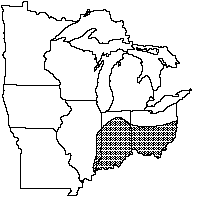Epioblasma rangiana (Lea, 1839)

Length: 1.8 inches (4.6 cm) for both male (top) and female (bottom).
Other common names: White-mouth riffleshell.
Key characters: Males and females yellowish brown or green but much different in shape. Males oblong with a sulcus running along the posterior ridge from the umbo to the ventral margin. Females with a large expanded posterior end. Tubercles on the lateral surface greatly reduced or absent.
Similar species: Tubercled blossom.
Description: Shell elongate, thick anteriorly, much thinner posteriorly, and compressed. Anterior margin rounded, posterior-ventral margin broadly rounded in females, indented in males. Umbos low, somewhat turned forward. Tubercles or knobs on the lateral surface greatly reduced or absent. A wide, shallow sulcus or depression present between the posterior and medial ridges. Periostracum yellowish brown with numerous fine green rays, obscure in older shells. Length to 2 inches (5.1 cm).

Pseudocardinal teeth triangular, divergent, and roughened; two in the left valve, one in the right, with two smaller teeth on either side. Lateral teeth moderately long, straight, and roughened; two in the left valve, one in the right with a much smaller tooth below. Beak cavity moderate to shallow. Nacre white, iridescent posteriorly.
Habitat: Medium to large rivers in gravel riffles.
Status: Proposed for Federal Endangered status. Endangered in Indiana, Michigan, and Ohio. Extirpated from Illinois.

